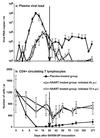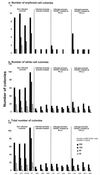Early and persistent bone marrow hematopoiesis defect in simian/human immunodeficiency virus-infected macaques despite efficient reduction of viremia by highly active antiretroviral therapy during primary infection
- PMID: 11689641
- PMCID: PMC114746
- DOI: 10.1128/JVI.75.23.11594-11602.2001
Early and persistent bone marrow hematopoiesis defect in simian/human immunodeficiency virus-infected macaques despite efficient reduction of viremia by highly active antiretroviral therapy during primary infection
Abstract
The hematological abnormalities observed in human immunodeficiency virus (HIV)-infected patients appear to be mainly due to bone marrow dysfunction. A macaque models of AIDS could greatly facilitate an in vivo approach to the pathogenesis of such dysfunction. Here, we evaluated in this model the impact of infection with a pathogenic simian/human immunodeficiency virus (SHIV) on bone marrow hematopoiesis. Three groups of macaques were inoculated with 50 50% median infective doses of pathogenic SHIV 89.P, which expresses env of dual-tropic HIV type 1 (HIV-1) 89.6 primary isolate. During the primary phase of infection, animals were treated with either a placebo or highly active antiretroviral therapy (HAART) combining zidovudine, lamivudine, and indinavir, initiated 4 or 72 h postinfection (p.i.) and administered twice a day until day 28 p.i. In both placebo-treated and HAART-treated animals, bone marrow colony-forming cells (CFC) progressively decreased quite early, during the first month p.i. One year p.i., both placebo- and HAART-treated animals displayed decreases in CFC to about 56% of preinfection values. At the same time, a dramatic decrease (greater than 77%) of bone marrow CD34(+) long-term culture-initiating cells was noted in all animals were found. No statistically significant differences between placebo- and HAART-treated monkeys were found. These data argue for an early and profound alteration of myelopoiesis at the level of the most primitive CD34(+) progenitor cells during SHIV infection, independently of the level of viremia, circulating CD4(+) cell counts, or antiviral treatment.
Figures






Similar articles
-
Early bone marrow hematopoietic defect in simian/human immunodeficiency virus C2/1-infected macaques and relevance to advance of disease.J Virol. 2004 Oct;78(20):10906-10. doi: 10.1128/JVI.78.20.10906-10910.2004. J Virol. 2004. PMID: 15452210 Free PMC article.
-
Altered clonogenic capability and stromal cell function characterize bone marrow of HIV-infected subjects with low CD4+ T cell counts despite viral suppression during HAART.Clin Infect Dis. 2008 Jun 15;46(12):1902-10. doi: 10.1086/588480. Clin Infect Dis. 2008. PMID: 18462177
-
Prevention of vaginal simian immunodeficiency virus transmission in macaques by postexposure prophylaxis with zidovudine, lamivudine and indinavir.AIDS. 2009 Feb 20;23(4):447-54. doi: 10.1097/QAD.0b013e328321302d. AIDS. 2009. PMID: 19240457
-
Molecular biological assessment methods and understanding the course of the HIV infection.APMIS Suppl. 2003;(114):1-37. APMIS Suppl. 2003. PMID: 14626050 Review.
-
Effect of human immunodeficiency virus infection on haematopoiesis.Baillieres Clin Haematol. 1995 Mar;8(1):113-30. doi: 10.1016/s0950-3536(05)80234-3. Baillieres Clin Haematol. 1995. PMID: 7545035 Review.
Cited by
-
Understanding and exploiting dendritic cells in human immunodeficiency virus infection using the nonhuman primate model.Immunol Res. 2006;36(1-3):265-74. doi: 10.1385/IR:36:1:265. Immunol Res. 2006. PMID: 17337787 Review.
-
HIV-1 infection of bone marrow hematopoietic progenitor cells and their role in trafficking and viral dissemination.PLoS Pathog. 2008 Dec;4(12):e1000215. doi: 10.1371/journal.ppat.1000215. Epub 2008 Dec 26. PLoS Pathog. 2008. PMID: 19112504 Free PMC article. Review.
-
Gut-Associated Plasmacytoid Dendritic Cells Display an Immature Phenotype and Upregulated Granzyme B in Subjects with HIV/AIDS.Front Immunol. 2015 Sep 24;6:485. doi: 10.3389/fimmu.2015.00485. eCollection 2015. Front Immunol. 2015. PMID: 26441989 Free PMC article.
-
Susceptibilities of simian immunodeficiency virus to protease inhibitors.Antimicrob Agents Chemother. 2003 May;47(5):1756-9. doi: 10.1128/AAC.47.5.1756-1759.2003. Antimicrob Agents Chemother. 2003. PMID: 12709355 Free PMC article.
-
HIV and SIV infection: the role of cellular restriction and immune responses in viral replication and pathogenesis.APMIS. 2009 May;117(5-6):400-12. doi: 10.1111/j.1600-0463.2009.02450.x. APMIS. 2009. PMID: 19400864 Free PMC article. Review.
References
-
- Adams G B, Pym A S, Poznansky M C, McClure M O, Weber J N. The in vivo effects of combination antiretroviral drug therapy on peripheral blood CD34+ cell colony-forming units from HIV type 1-infected patients. AIDS Res Hum Retroviruses. 1999;15:551–559. - PubMed
-
- Aiuti A, Turchetto L, Cota M, Cipponi A, Brambilla A, Arcelloni C, Paroni R, Vicenzi E, Bordignon C, Poli G. Human CD34(+) cells express CXCR4 and its ligand stromal cell-derived factor-1. Implications for infection by T-cell tropic human immunodeficiency virus. Blood. 1999;94:62–73. - PubMed
-
- Brogan K L, Zell S C. Hematologic toxicity of zidovudine in HIV-infected patients. Am Fam Physician. 1990;41:1521–1528. - PubMed
-
- Broxmeyer H E, Sherry B, Cooper S, Lu L, Maze R, Beckmann M P, Cerami A, Ralph P. Comparative analysis of the human macrophage inflammatory protein family of cytokines (chemokines) on proliferation of human myeloid progenitor cells. Interacting effects involving suppression, synergistic suppression, and blocking of suppression. J Immunol. 1993;150:3448–3458. - PubMed
-
- Calenda V, Chermann J C. HIV Tat protein potentiates in vitro granulomonocytic progenitor cell growth. Eur J Haematol. 1995;54:180–185. - PubMed
Publication types
MeSH terms
Substances
LinkOut - more resources
Full Text Sources
Medical
Research Materials

